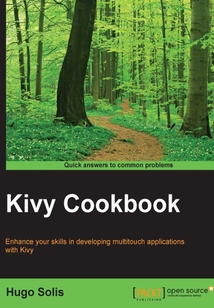目錄(117章)
倒序
- coverpage
- Kivy Cookbook
- Credits
- About the Author
- About the Reviewers
- www.PacktPub.com
- Support files eBooks discount offers and more
- Preface
- What this book covers
- What you need for this book
- Who this book is for
- Sections
- Conventions
- Reader feedback
- Customer support
- Chapter 1. Kivy and the Kv Language
- Introduction
- Installing Kivy
- Building your interfaces
- Declaring properties within a class
- Relating Python code and the Kv language
- Referencing widgets
- Accessing widgets defined inside the Kv language in your Python code
- Reusing styles in multiple widgets
- Designing with the Kv language
- Running your code
- Using Kivy garden
- Chapter 2. Input Motion and Touch
- Introduction
- Using the mouse
- Evolving to the touchscreen
- Working with the accelerometer
- Using the gyroscope
- The differences between the touch and motion events
- Recognizing touch shapes
- Detecting multitapping
- Grabbing touch events
- Recording gestures
- Chapter 3. Events
- Introduction
- Scheduling a one-time event
- Scheduling a repetitive event
- Triggering events
- Defining widget events
- Creating custom events
- Attaching callbacks
- Declaring a property
- Compounding properties
- Chapter 4. Widgets
- Introduction
- Using the basics: buttons labels and text inputs
- Manipulating the widget tree
- Traversing the tree
- Using swappable widgets
- Organizing with layouts
- Using FloatLayout
- Using BoxLayout
- Using GridLayout
- Using StackLayout
- Using RelativeLayout
- Using AnchorLayout
- Working with ActionBar
- Chapter 5. Graphics – Canvas and Instructions
- Introduction
- Separating with the screen manager
- Using drawing instructions
- Using context instructions
- Working with manipulating instructions
- Rotating translating and scaling the canvas
- Modifying with multitouching
- Storing and retrieving the coordinate space context
- Introducing animations
- Chapter 6. Advanced Graphics – Shaders and Rendering
- Introduction
- Using Carousel
- Creating and using Atlas
- Creating layouts
- Editing shaders
- Creating widgets
- Creating your own shader
- Rendering in a Framebuffer
- Optimizing graphics
- Chapter 7. The API in Detail
- Introduction
- Getting to know the API
- Using the asynchronous data loader
- Logging objects
- Parsing
- Applying utils
- Leveraging the factory object
- Working with audio
- Working with video
- Working with a camera
- Using spelling
- Adding effects
- Advanced text manipulation
- Chapter 8. Packaging our Apps for PC
- Introduction
- Packaging for Windows
- Including multimedia for Windows
- Running apps in Windows
- Packaging for Mac OS
- Including multimedia for Mac OS
- Running apps in Mac OS
- Packaging for Linux
- Including multimedia for Linux
- Running apps in Linux
- Chapter 9. Kivy for Mobile Devices
- Introduction
- Packaging for iOS
- Resizing the screen into iOS
- Leveraging mobile features in iOS
- Preparing for the App Store
- Packaging for Android
- Resizing the screen into Android
- Leveraging mobile features in Android
- Index 更新時間:2021-07-16 20:40:11
推薦閱讀
- The Complete Rust Programming Reference Guide
- Mastering Entity Framework Core 2.0
- Learning Cython Programming
- Mastering RabbitMQ
- MongoDB權威指南(第3版)
- 學Python也可以這么有趣
- 小程序開發原理與實戰
- Visual FoxPro程序設計
- R Data Analysis Cookbook(Second Edition)
- Mastering JavaScript Design Patterns(Second Edition)
- OpenCV 3 Blueprints
- Training Systems Using Python Statistical Modeling
- QlikView Unlocked
- 數據分析與挖掘算法:Python實戰
- Node.js應用開發
- 讓Python遇上Office:從編程入門到自動化辦公實踐
- Elastix Unified Communications Server Cookbook
- 大話程序員:從入門到優秀全攻略
- Python實戰指南:手把手教你掌握300個精彩案例
- 區塊鏈原理、架構與應用(第2版)
- Java EE企業級應用開發教程:Spring+Spring MVC+MyBatis(第2版)
- Hands-On Exploratory Data Analysis with Python
- Excel VBA活用范例實用手冊(暢銷升級版)
- Arduino Networking
- Implementing Qlik Sense
- Large Scale Machine Learning with Spark
- 深入淺出:.NET框架設計與實現
- MATLAB從基礎到精通
- Learning VMware NSX(Second Edition)
- JavaScript at Scale


